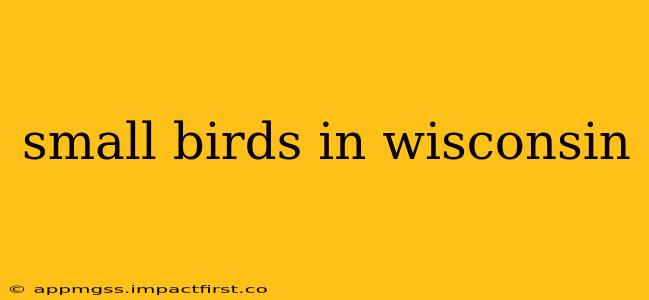Wisconsin, with its diverse habitats ranging from forests and prairies to wetlands and urban areas, supports a vibrant population of small birds. Identifying these feathered friends can be a rewarding hobby, and understanding their characteristics and habitats enhances the experience. This guide explores some of the common small birds you might encounter in the Badger State, addressing frequently asked questions to provide a complete overview.
What are some of the smallest birds in Wisconsin?
Several tiny birds call Wisconsin home. Among the smallest are the goldcrest, a tiny warbler with a distinctive yellow crest, the ruby-crowned kinglet, known for its hidden crown jewel, and the brown creeper, a tiny, unobtrusive bird that spirals up tree trunks. These birds are often overlooked due to their size and camouflaged plumage. However, with a keen eye and a good pair of binoculars, you can spot them flitting among the branches.
What are the common small birds I might see in my backyard in Wisconsin?
Your Wisconsin backyard might host a variety of small bird species depending on the landscaping and available food sources. Common visitors include the house wren, known for its cheerful song and fondness for nesting in birdhouses, the chickadee, a friendly and sociable bird that readily visits feeders, and the downy woodpecker, the smallest woodpecker in Wisconsin, often seen foraging on tree trunks. Planting native shrubs and trees and providing a bird bath and feeders can attract even more feathered friends.
What are some small songbirds found in Wisconsin forests?
Wisconsin's forests are home to many small songbirds. The ovenbird, named for its distinctive oven-shaped nest, is a common sight, as are various warblers, including the yellow warbler, black-throated green warbler, and blackburnian warbler. These birds often inhabit the understory and canopy, their vibrant songs echoing through the trees. Identifying them can be a challenging but rewarding endeavor requiring observation of plumage details and listening carefully to their songs.
How can I attract small birds to my Wisconsin garden?
Attracting small birds to your garden is a satisfying way to connect with nature. Planting native trees, shrubs, and flowers provides food and shelter. Consider adding a variety of plants to support different species, including those with berries and seeds. Providing a clean water source, such as a bird bath, is also crucial, especially during hot summer months. Finally, offering appropriate birdseed in feeders can attract many species. Refrain from using pesticides, as these can harm birds and insects they depend on.
What small birds are migratory in Wisconsin?
Many of the small birds found in Wisconsin are migratory, spending the breeding season in the state and then migrating south for the winter. Warblers, vireos, flycatchers, and many other small birds typically leave Wisconsin in the autumn to escape harsh winter conditions. Their departure marks the end of the breeding season and the beginning of a long journey to warmer climates. Observing their movements and noting their departure and arrival times can be a fascinating aspect of birdwatching.
What resources are available to help identify small birds in Wisconsin?
Numerous resources are available to aid in identifying small birds in Wisconsin. Field guides, such as the Sibley Guide to Birds or the National Geographic Field Guide to the Birds of North America, are invaluable tools. Online resources, like the eBird website, allow you to record your sightings and learn about bird distributions. Local Audubon societies and nature centers often offer bird walks and identification workshops, providing opportunities for hands-on learning. Utilizing a combination of these resources will significantly enhance your bird identification skills.
This guide provides a starting point for exploring the diverse world of small birds in Wisconsin. With patience, observation, and the use of available resources, you can discover the fascinating lives of these tiny creatures and appreciate the rich avian biodiversity of the state. Happy birding!
